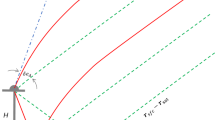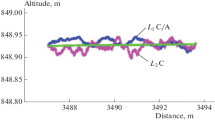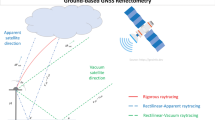Abstract
Changes in GPS transmitter and receiver antenna orientations induce variations in observed carrier phase values. An analytic formula for this well-known carrier phase wind-up correction is derived which generalizes a previous result. In addition, it is shown that in GPS reflectometry the wind-up values of direct and coherently reflected rays may differ by up to several centimeters. The results are discussed on the basis of simulated measurements.







Similar content being viewed by others
References
Anderson KD (2000) Determination of water level and tides using interferometric observations of GPS signals. J Atmos Ocean Tech 17(8):1118–1127. doi:10.1175/1520-0426
Bar-Sever YE (1996) A new model for GPS yaw attitude. J Geod 70(11):714–723
Beutler G et al (2007) Bernese GPS software version 5.0, Tech. rep., Astronomical Institute, University of Bern
Born M, Wolf E (1980) Principles of optics. Pergamon Press, Oxford
Bronstein IN, Semendjajew KA (1981) Taschenbuch der Mathematik, Verlag Harri Deutsch, Thun
Cardellach E, Ribó S, Rius A (2006) Technical note on polarimetric phase interferometry (POPI), Tech. Rep. http://arxiv.org/abs/physics/0606099
García-Fernández M, Markgraf M, Montenbruck O (2008) Spin rate estimation of sounding rockets using GPS wind-up. GPS Solut 12(3):155–161
Hecht E, Zajac A (1997) Optics. Addison Wesley, Reading
Jackson JD (1999) Classical electrodynamics. Wiley, New York
Kim D, Serrano L, Langley R (2006) Phase wind-up analysis: assessing real-time kinematic performance. GPS World 17(9):58–64
Martìn-Neira M, Caparrini M, Font-Rosello J, Lannelongue S, Vallmitjana CS (2001) The PARIS concept: an experimental demonstration of sea surface altimetry using GPS reflected signals. IEEE Trans Geosci Remote Sens 39(1):142–150
Misra P, Enge P (2006) Global positioning system: signals, measurements, and performance. Ganga-Jamuna Press, Lincoln
Montenbruck O, García-Fernández M, Yoon Y, Schön S, Jäggi A (2008) Antenna phase center calibration for precise positioning of LEO satellites, GPS Solut. 12, publ. online. doi:10.1007/s10291-008-0094-z
Schmid R, Steigenberger P, Gendt G, Ge M, Rothacher M (2007) Generation of a consistent absolute phase-center correction model for GPS receiver and satellite antennas. J Geod 81(12):781–798
Tetewsky AK, Mullen FE (1997) Carrier phase wrap-up induced by rotating GPS antennas. GPS World 8(2):51–57
Treuhaft RN, Lowe ST, Zuffada C, Chao Y (2001) 2-cm GPS altimetry over Crater lake. Geophys Res Lett 22(23):4343–4346
Wu JT, Wu SC, Hajj GA, Bertiger WI, Lichten SM (1993) Effects of antenna orientation on GPS carrier phase. Manuscripta Geodaetica 18(2):91–98
Acknowledgments
Helpful comments and suggestions by my colleagues at GFZ, Antonio Rius (IEEC, Barcelona) and an anonymous reviewer are gratefully acknowledged.
Author information
Authors and Affiliations
Corresponding author
Additional information
An erratum to this article can be found at http://dx.doi.org/10.1007/s10291-009-0154-z
Appendix
Appendix
In the following we first show that the phase wind-up value derived from Eq. 10 is identical to the value derived using Eq. 14 provided that the transmitter and receiver antenna boresight vectors \( \hat{t}^{b} \) and \( \hat{r}^{b} \) lie in one plane. We then derive Eq. 8.
The unit wave vector \( \hat{k} \) can then be written as a linear combination of \( \hat{t}^{b} \) and \( \hat{r}^{b} \)
where it is assumed that \( \hat{t}^{b} \) and \( \hat{r}^{b} \) are not collinear. We define nine parameters a, b, c, d, A, B, C, D and Δ by
noting that
Since the vectors \( \left[ {\hat{t}^{a} ,\hat{t}^{t} ,\hat{t}^{b} } \right] \) and \( \left[ {\hat{r}^{a} ,\hat{r}^{t} ,\hat{r}^{b} } \right] \) can be regarded as bases of cartesian coordinate systems, the matrix R is orthonormal, i.e.,
with the Kronecker delta defined by
For example, Eq. 29 translates into the following relations which will be used later
From Eq. 26 and \( \left| {\hat{k}} \right| = 1 \) it follows that
Equation 10 can now be re-written in terms of the parameters defined in Eq. 27,
Similarly, one obtains
In the next step, the products AD, BC, AC and BD are expressed in terms of a, b, c and d. For example, by squaring Eq. 31, inserting Eqs. 35, 34 and 33 and using Eq. 38 one obtains
Similarly, for the remaining products one finds
and Eq. 10 becomes
The corresponding expressions for Eq. 15 are
using Eqs. 26 and 37. Note that Eqs. 14 and 43 imply
Using Eqs. 43 and 37, \( \tilde{\Upphi } \) is given by
since
In Eq. 45 sgn(ζ) has been replaced by sgn(b + c) which is only admissible for 1 + α − β ≠ 0. However, if 1 + α − β = 0 the rhs of Eq. 46 was identically zero (see Eq. 37) contradicting Eq. 44.
With \( \arctan\!2(\sqrt {1 - x^{2} } ,x) = \arccos x, \) where −1≤ x ≤ +1, one finds for x ≡ (a − d)/(1 − Δ) that \( \sqrt {1 - x^{2} } = \left| {b + c} \right|/(1 - \Updelta ). \) Thus,
concluding the proof that \( \tilde{\Upphi } = \Upphi \) provided the transmitter and receiver antenna bore sight vectors \( \hat{t}^{b} \) and \( \hat{r}^{b} \) lie in one plane.
Equation 8 is derived in the following way: with sin Ω = (e iΩ − e −iΩ)/(2i) and cos Ω = (e iΩ + e −iΩ)/2 we find
Rights and permissions
About this article
Cite this article
Beyerle, G. Carrier phase wind-up in GPS reflectometry. GPS Solut 13, 191–198 (2009). https://doi.org/10.1007/s10291-008-0112-1
Received:
Accepted:
Published:
Issue Date:
DOI: https://doi.org/10.1007/s10291-008-0112-1




